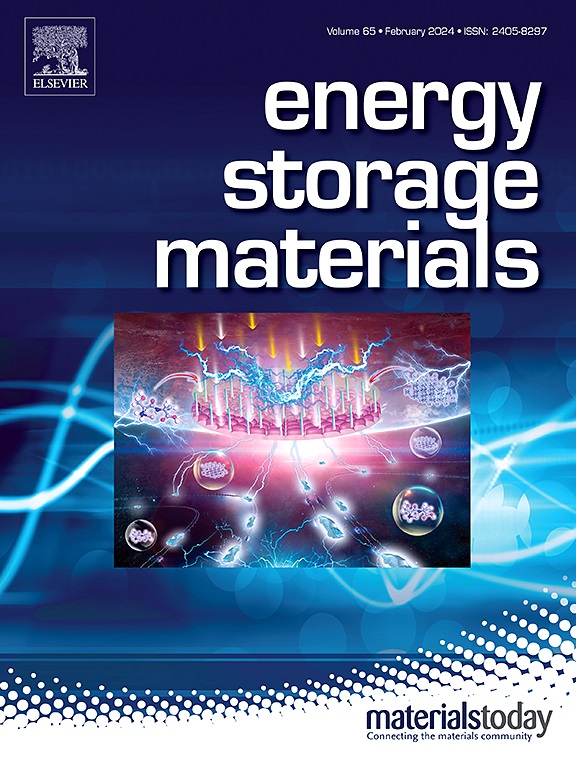锂离子电池硅-石墨复合阳极热稳定性机理研究
IF 18.9
1区 材料科学
Q1 CHEMISTRY, PHYSICAL
引用次数: 0
摘要
了解硅-石墨(Si-C)复合阳极热不稳定性的演化机制对于提高锂离子(Li-ion)电池的安全性和可靠性至关重要。本研究考察了硅含量和电荷状态对复合Si-C阳极和LiNixCoyMnzAl1-x-y-zO2 (NCMA)阴极组成的锂离子电池热电化学稳定性和安全性的耦合影响。揭示了Si-C成分在诱导电化学性能、阻抗特性和热稳定性方面的机制权衡中的关键作用。实现增强的热电化学稳定性需要最佳的Si-C成分,因为无si配方提供的改进很小,而过量的硅会增加内阻和热不稳定性。通过综合热稳定性分析,结合加速量热法和机理建模,我们确定了硅掺杂剂对阳极-硅放热反应的影响,减轻了固体电解质相间分解和阳极-粘结剂相互作用。在认识到热动力学反应机理的基础上,建立了预测大尺寸硅碳基锂离子电池热失控行为的分层模型框架。提出的热分析框架为评估硅基锂离子化学物质的热稳定性和安全性建立了基线,为设计下一代高能量密度电池提供了关键见解。本文章由计算机程序翻译,如有差异,请以英文原文为准。
Mechanistic understanding of silicon-graphite composite anode thermal stability in lithium-ion batteries
Understanding the mechanistic evolution of thermal instability in silicon-graphite (Si-C) composite anodes is crucial for advancing the safety and reliability of lithium-ion (Li-ion) cells. This study investigates the coupled influence of silicon content and state-of-charge on the thermo-electrochemical stability and safety of Li-ion cells comprising composite Si-C anodes and LiNixCoyMnzAl1-x-y-zO2 (NCMA) cathodes. The pivotal role of Si-C composition in inducing mechanistic tradeoffs with respect to the electrochemical performance, impedance characteristics, and thermal stability is revealed. Achieving enhanced thermo-electrochemical stability requires an optimal Si-C composition, as Si-free formulations offer minimal improvements, while excessive silicon increases internal resistance and thermal instabilities. Through a comprehensive thermal stability analysis, combining accelerating rate calorimetry and mechanistic modeling, we identify the impact of silicon dopants in affecting the anode-silicon exothermic reactions and mitigating the solid electrolyte interphase decomposition and anode-binder interactions. Cognizant of the thermo-kinetic reaction mechanisms, a hierarchical modeling framework is established to predict the thermal runaway behavior of large-format Si-C based Li-ion cells. The proposed thermal analytics framework establishes a baseline for evaluating the thermal stability and safety of Si-based Li-ion chemistries, providing critical insights for designing next-generation batteries with high energy density.
求助全文
通过发布文献求助,成功后即可免费获取论文全文。
去求助
来源期刊

Energy Storage Materials
Materials Science-General Materials Science
CiteScore
33.00
自引率
5.90%
发文量
652
审稿时长
27 days
期刊介绍:
Energy Storage Materials is a global interdisciplinary journal dedicated to sharing scientific and technological advancements in materials and devices for advanced energy storage and related energy conversion, such as in metal-O2 batteries. The journal features comprehensive research articles, including full papers and short communications, as well as authoritative feature articles and reviews by leading experts in the field.
Energy Storage Materials covers a wide range of topics, including the synthesis, fabrication, structure, properties, performance, and technological applications of energy storage materials. Additionally, the journal explores strategies, policies, and developments in the field of energy storage materials and devices for sustainable energy.
Published papers are selected based on their scientific and technological significance, their ability to provide valuable new knowledge, and their relevance to the international research community.
 求助内容:
求助内容: 应助结果提醒方式:
应助结果提醒方式:


